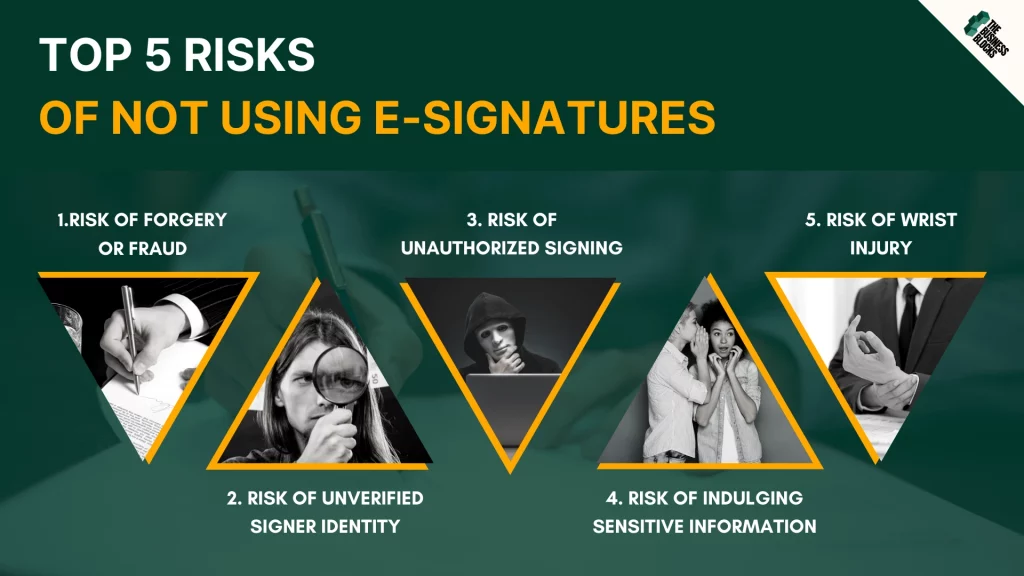Moving business approvals online without knowing the important steps to take is not an easy task. It’s crucial to understand the potential risks of not ensuring your digital signatures with appropriate authorization. Therefore, updating your authorized signatories list is a vital part when using e-signatures.
If you’re still not using electronic signatures in your business processes, there are also some risks to consider. Moreover, we will discuss the best practices to mitigate the most common issues in adopting e-signing. So, what are the possible disadvantages of not using digital signatures today?
Let us review the top 5 risks in this article.
Are you Considering whether or not to use Digital Signatures?
Digital signatures are becoming increasingly popular in banking, health care, education, and government industries. They provide a reliable way of securely signing documents with an unmistakable signature that is legally binding and virtually unalterable. But what are the risks associated with avoiding digital signatures?
Learn how to keep your business secure and protect yourself from potential legal consequences with up-to-date security solutions that include digital signature technology.
With further innovations increasing their ease of use and greater prevalence, now is the time for businesses everywhere to implement these standards in their operations.
Why You Should Move to E-signatures?
Perhaps, you’re still not convinced that digital signatures are safe to use. That’s ok if you are, then you can check out our picks for the best e-signature platforms here.
If so, here are the top 5 risks of not using digital signatures in your daily transactions:

1. Risk of forgery or fraud.
Forgery has been a major concern since people started to sign their names on legal documents. Unlike e-signatures, it is easier to forge a signature on physical documents nowadays. Dedicated electronic signature platforms ensure that authentication issues are properly addressed throughout the e-signing process.
Many electronic signatory software platforms today are equipped with the right tools to prevent hacking or compromising e-signatures and sensitive information. For instance, you can adopt an extra anti-fraud feature such as an authentication confirmation through phone calls.
2. Risk of unverified signer identity.
When you use physical signatures on important documents, there is a risk of unverified signatory identity. Anyone can sign the paper without a verified identity unlike in digital signatures. E-signature technology now provides different options when it comes to verifying the identities of signatories.
Before accessing and signing documents online, it’s a protocol to verify the person’s identity including the email address, access code, ID verification, knowledge-based questions, and phone number verification. It’s a more rigid process than the traditional signing of documents.
3. Risk of unauthorized signing.
Wet ink signatures are riskier of unauthorized signing than electronic signatures. E-signatories are thoroughly checked and appropriately authorized to sign online documents. In addition, they understand what they are exactly signing for.
Organizations are now allowed by blockchain technologies to securely and efficiently manage digital signatories in real-time while having a clear and complete audit trail of any data changes. E-signatures are guaranteed to follow both international digital signature laws as well as local rules and regulations to ensure reliability and security.
4. Risk of divulging sensitive information.
When you physically sign and handle contracts and other sensitive documents, any sensitive information can be intentionally disclosed. With digital signatures, you have the security-first approach to counter any potential hacking.
Depending on the provider, e-signature security measures may include security certifications, platform security, and physical security to protect the system wherever they reside. These security programs are designed as malware protection, real-time data replication, commercial-grade firewalls, data encryption, signature verification, and compliance with relevant standards such as ISO 27001:2013, CSA Security Trust Assurance and Risk program, and SOC 1 Type 2 and SOC 2 Type 2. In fact the DataCo International UK Limited ISO 27001 certification process is crucial to developing a network security strategy, and so picking an e-signature solution that adheres to the best practices and principles of this framework will stand you in good stead. It’s an example of how digital tech can be more secure, and aid in compliance to a greater degree, than analog equivalents.
In fact the ISO 27001 certification process is crucial to developing a network security strategy, and so picking an e-signature solution that adheres to the best practices and principles of this framework will stand you in good stead. It’s an example of how digital tech can be more secure, and aid in compliance to a greater degree, than analog equivalents.
5. Risk of a wrist injury.
One of the most common issues of signing papers is experiencing wrist injury after working on reams of documents in one sitting. In addition, ink, paper, and pens only add to more waste. The best solution is to adopt and accept electronic signatures for your contracting process.
Using e-signatures helps cut down on waste while protecting yourself against wrist injury. Many businesses are now adopting digital signatures to eliminate manual processes when managing their contracts and other documents. For example, companies are using electronically signed agreements with clients.
E-signatures are practical because you don’t have to physically sign agreements every time you accept a new contract or download an online app. Customers will look for another service if you keep on asking them to sign your terms and conditions every time they download your app.
Benefits of Adopting E-signatures
From your business transactions to customer experience, e-signatures have many advantages that you should consider.
- The most obvious benefit is the time savings.From a fast and easy signing process, your customers would also appreciate this convenience when they don’t need a physical pen or ink to sign documents. A digital document with a digital signature is more secure, accurate, and efficient than paper documents with a handwritten signature.
- E-Signatures also minimize the need for costly document storage and retrieval.This means you don’t have to worry about maintaining paper documents in a secure place, as all records are stored securely online.
- E-signatures offer greater security benefits, malware protection, real-time data replication, commercial-grade firewalls, and encryption.This helps protect sensitive data from being accessed by unauthorized personnel. The digital signature also provides legal enforceability and a permanent audit trail of every document signed. The signature processing and private key encryption add an extra layer of protection.
- Easily track the signing process to ensure all parties comply with the regulations for their business transactions.From a digital signature certificate to a simple digital signature processing, e-signing can be used for any business document with public and private keys to authenticate the signature.You can also use it in legal agreements, contracts, and non-disclosure documents. The digital signatures work anywhere worldwide, as long as you can access a computer or internet connection.
A digital signature works as a simplified, secure communication and authentication platform for both parties involved in a transaction. It is also compliant with industry standards.
Apart from the legal and secure aspect, electronic signatures also help to streamline your workflow, creation and collaboration process. With e-signing capabilities, you can quickly complete digital certificates and contracts and draft new ones even faster.
Best Practices to Mitigate the Issues in Adopting E-signing
E-signatures are safer and more secure than wet signatures for many reasons. They are less likely to be tampered with, forged, copied, and misused. Digital signatures have multiple layers of authentication and security levels as well as court-admissible proof of transactions for future reference.
Below are the best practices you can implement while using electronic signatures in your business processes:
- Use a cloud-based e-signature platform to authenticate your contracting process and a signer authorization platform to create another layer of protection from potential hacking and other cybersecurity attacks.
- Build an internal e-signatory procedure or create a formal policy to ensure safety when using digital signatures. You may also consider adding an anti-fraud control with certain compliance measures to protect sensitive information.
- Approve additional signers, if necessary.
- Update signer list regularly to keep it easily accessible.
- Verify with a legal adviser if using electronic signatures applies to such transactions.
With a well-designed e-signing platform, you can take advantage of the benefits of digital signature technology. Fundamentally, it helps prevent legal risks while reducing other potential threats to your documents as they are being processed. It’s more reliable and legally binding than physical signing.
Employees responsible for signing parties for legal, IT, compliance, risk, and operations management should understand the importance of verifying and authenticating signatories and their identities. Moreover, preserving the integrity of signed papers with electronic signatures is also important.
Frequently Asked Questions About Top 5 Risks of Not Using Digital Signatures
Q: Are Digital Signatures legally binding to use e-signatures?
A: Yes. Using e-signatures in many countries, including the United States and most of Europe, is legally binding. However, you must ensure that your contracts are valid and enforceable by consulting a legal adviser beforehand.
Q: What are the disadvantages of digital signatures?
A: The main disadvantage of digital signatures is that they can be hacked or duplicated. Moreover, other risks are associated with digital signatures, such as phishing attacks, malware, and identity theft.
Q: Are electronic and digital signatures same?
A: No, they are not. Electronic signatures are any mark or symbol used to signify a person’s agreement with an online contract. While digital signatures use encryption standards and public key infrastructure (PKI) technology to verify the identity certificate authority of the signer.
Q: What is an electronic document authentication process?
A: Electronic document authentication involves multiple steps, such as verifying the signer’s identity, signing the document, creating an audit trail, and archiving signed document.
Key Takeaway
Digital signatures are useful when you know how to take advantage of them. They are more environmentally friendly and a great time saver compared to wet-ink signatures.
Nevertheless, if you don’t manage it correctly, there are risks of not using digital signatures that can be potentially disadvantageous for your business processes and may lead to fraud, identity theft, and forgery.
A reliable e-signatory management platform can help provide you with a secure signatory process with real-time results that are accessible from remote locations.
This is the next big thing in the business world, and it’s a smart decision to understand its features and benefits. Want to find out more about digital signatures? Get updated here on our website.
Featured Platforms: PandaDoc, Formstack Sign, DocuSign, HelloSign
